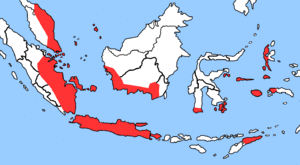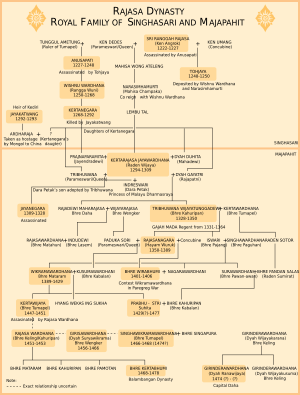Singhasari facts for kids
Quick facts for kids
Singhasari
ꦱꦶꦔ꧀ꦲꦱꦫꦶ (Javanese)
|
|||||||||||
|---|---|---|---|---|---|---|---|---|---|---|---|
| 1222–1292 | |||||||||||
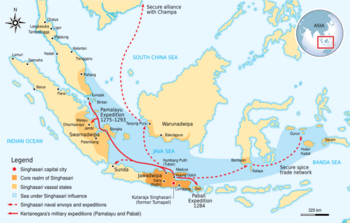
Expansion of Singhasari during the reign of Kertanegara
|
|||||||||||
| Capital | Tumapel, later called Kutaraja Singhasari (modern outskirt Malang) | ||||||||||
| Common languages | Old Javanese, Sanskrit | ||||||||||
| Religion | Kejawen, Hinduism, Buddhism, Animism | ||||||||||
| Government | Monarchy | ||||||||||
| Maharaja | |||||||||||
|
• 1222–1227
|
Ken Arok | ||||||||||
|
• 1268–1292
|
Kertanegara | ||||||||||
| History | |||||||||||
|
• Coronation of Ken Arok
|
1222 | ||||||||||
|
• Invasion by Jayakatwang of Kediri
|
1292 | ||||||||||
| Currency | Native gold and silver coins | ||||||||||
|
|||||||||||
| Today part of | |||||||||||
Singhasari (Javanese: ꦏꦫꦠꦺꦴꦤ꧀ꦱꦶꦔ꧀ꦲꦱꦫꦶ, romanized: Karaton Singhasari or Karaton Singosari, Indonesian: Kerajaan Singasari), also known as Tumapel, was a powerful Javanese kingdom. It was located in eastern Java and existed between the years 1222 and 1292. This kingdom followed the Kingdom of Kediri as the main power in East Java. The name Singhasari is similar to the Singosari district you can find today near Malang City.
Contents
What's in a Name?
The name Singhasari (sometimes spelled Singosari) appears in old Javanese writings. People say that Ken Arok gave the kingdom this name when he founded it. Before that, it was called Tumapel. The word singha means "lion" in Sanskrit. The word sari in Old Javanese can mean "essence" or "to sleep." So, Singhasari could mean "essence of lion" or "sleeping lion." Even though lions don't live in Java, the idea of lions is important in Indonesian culture. This comes from Hindu and Buddhist beliefs.
How Singhasari Began
Singhasari was started by Ken Arok (who lived from about 1182 to 1227). His story is a famous folktale in Java. Much of what we know about Ken Arok and early Singhasari comes from an old text called the Pararaton. This text also includes some mythical parts. Ken Arok grew up as an orphan in the Kingdom of Kediri.
Ken Arok started as a helper for Tunggul Ametung, a local leader in Tumapel (which is now Malang). He eventually became the ruler of Java. He is seen as the founder of the Rajasa dynasty, which ruled both Singhasari and later the Majapahit kingdom. Ken Arok was later killed by Anusapati, who was getting revenge for his father's death. Ken Arok's son, Panji Tohjaya, then killed Anusapati. However, Panji Tohjaya ruled for only a few months in 1248 before his nephews rebelled. These two, Ranga Wuni and Mahisha Champaka, ruled together.
Growing the Kingdom
In 1275, King Kertanegara became the fifth ruler of Singhasari. He had been king since 1254. He sent a peaceful naval mission north to the weaker parts of Srivijaya. This was to stop pirate attacks and invasions from India. The strongest kingdoms in the Malaya region at that time were Jambi, Dharmasraya, and Temasek (Singapore).
This military trip was called the Pamalayu expedition. It was led by Admiral Mahesa Anabrang. The goal was also to protect the Malayan strait, which was a busy trade route. This was important to prevent possible invasions from the Mongols and to stop sea pirates. The kingdoms in Malaya then agreed to be loyal to Singhasari. King Kertanegara wanted Singhasari to become a powerful sea empire, controlling trade routes from China to India.
The Pamalayu expedition lasted from 1275 to 1292. It is written about in a Javanese scroll called Nagarakrtagama. Singhasari's lands later became part of the Majapahit kingdom. In 1284, King Kertanegara also sent an army to Bali, bringing Bali under Singhasari's control. The king also sent troops and messengers to other nearby kingdoms. These included the Sunda-Galuh Kingdom, Pahang Kingdom, Balakana Kingdom (Borneo), and Gurun Kingdom (Maluku). He also made friends with the king of Champa (Vietnam).
By 1290, King Kertanegara had removed all Srivijayan influence from Java and Bali. However, these big campaigns used up most of the kingdom's military forces. This later led to a dangerous plan against King Kertanegara.
Facing the Mongols
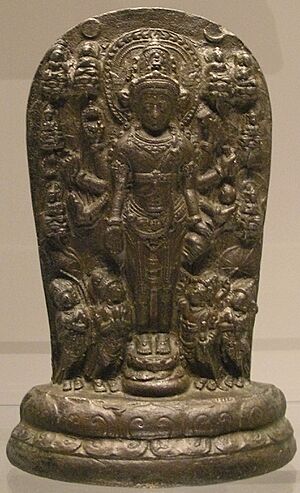
Singhasari, and the kingdom that came after it, Majapahit, were some of the few kingdoms in Asia that stopped an invasion by the Mongol army. They pushed back a Mongol force in 1293. The Javanese Singhasari empire was growing in power and wealth. This caught the attention of Kublai Khan, the leader of the Mongol Yuan dynasty in China. Singhasari had also made friends with Champa, another strong state nearby. Both Java (Singhasari) and Champa were worried about the Mongols expanding and attacking their neighbors.
Kublai Khan sent messengers to Java, demanding that Singhasari surrender and pay him money. In 1280, the first messenger was sent to King Kertanegara. The king refused. In 1281, another messenger came with the same demand, and it was refused again. Eight years later, in 1289, the last messenger was sent. King Kertanegara still refused to pay.
In the Singhasari court, King Kertanegara showed great disrespect to the Mongol messenger, Meng Ki. He cut and scarred the messenger's face. The messenger went back to China with the king's answer written on his face.
Kublai Khan was very angry about this insult. In late 1292, he sent 1,000 war junks (large ships) for a military attack. They arrived off the coast of Tuban, Java, in early 1293.
King Kertanegara's troops were spread out in other places. He did not know that a secret plan was being made against him by the old Kediri royal family.
The End of Singhasari
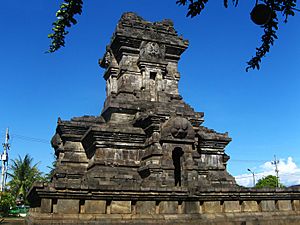
In 1292, Regent Jayakatwang, a local ruler from the Kingdom of Daha (also known as Kediri), prepared his army. His goal was to conquer Singhasari and kill its king. He was helped by Arya Viraraja, a regent from Sumenep on the island of Madura.
The Kediri army attacked Singhasari from both the north and the south at the same time. The king only knew about the attack from the north. He sent his son-in-law, Nararya Sanggramawijaya (also known as 'Raden Wijaya'), to stop this rebellion. The northern attack was held back. However, the southern attackers were not noticed until they reached and attacked the capital city of Kutaraja. Jayakatwang took over and killed Kertanagara during a special ceremony. This brought an end to the Singhasari kingdom.
When Raden Wijaya learned that Singhasari's capital had fallen due to Kediri's trick, he tried to defend it but failed. He and his three friends, Ranggalawe, Sora, and Nambi, went into hiding. They sought help from Arya Wiraraja of Madura, Nambi's father, who then turned against Jayakatwang. With Arya Wiraraja's help, Raden Wijaya pretended to surrender to King Jayakatwang. He gained favor from the new Kediri king, who allowed him to start a new settlement north of Mount Arjuna. This place was called the Tarik forest. In this wild area, Wijaya found many bitter Maja fruits. So, the place was named Majapahit (meaning "bitter Maja"). This would become the future capital of a great empire.
The Start of the Majapahit Empire
In early 1293, the Mongol navy arrived on the north coast of Java. They planned to attack what they thought was Singhasari. Raden Wijaya saw a chance to use the Mongols to defeat Jayakatwang. Raden Wijaya's army joined forces with the Mongols in March 1293. A battle happened between the Mongol forces and the Daha forces. The Mongols then attacked Daha, and Jayakatwang finally gave up and was killed.
Once Jayakatwang was gone, Raden Wijaya then turned his troops against his former Mongol allies. He forced them to leave the island of Java on May 31, 1293.
Prince Wijaya, who was the son-in-law of Kertanegara (the last Singhasari king), then became king. He took the name Kertajasa Jayawardhana. He was the first king of the great Majapahit Empire, starting on November 12, 1293.
Rulers of Singhasari
Here are the main rulers of the Singhasari kingdom:
- Ken Arok (1222–1227)
- Anusapati (1227–1248)
- Panji Tohjaya (1248)
- Vishnuvardhana-Narasimhamurti (1248–1268)
- Kertanegara (1268–1292)
Contemporary Inscriptions
Gondang Inscription
The Gondang Inscription is an old stone carving found in 2017. It dates back to the time of the Singhasari Kingdom. It was discovered in a rice field in Mojokerto Regency, East Java. The inscription is written in the Old Javanese language and is dated to 1197 Saka, which is 1275 AD.
See also
- List of monarchs of Java
- Kidal Temple
- Jago Temple
- Jawi Temple


